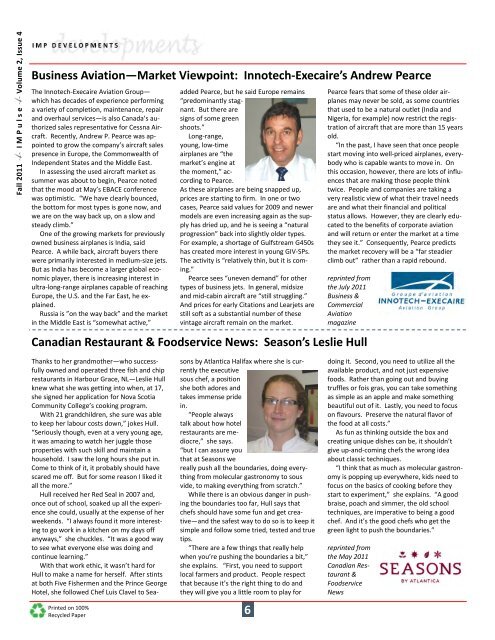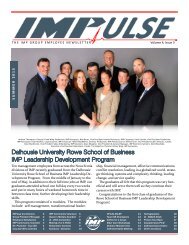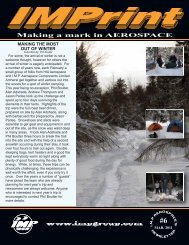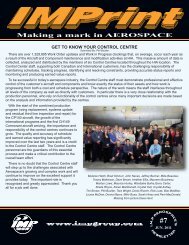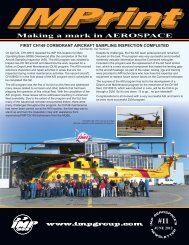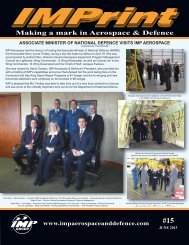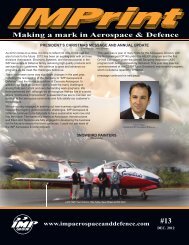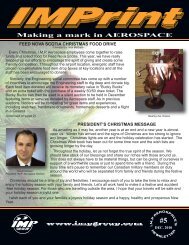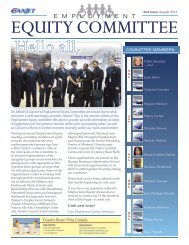IMPulse Volume 2, Issue 4 - Fall 2011 - IMP Group
IMPulse Volume 2, Issue 4 - Fall 2011 - IMP Group
IMPulse Volume 2, Issue 4 - Fall 2011 - IMP Group
Create successful ePaper yourself
Turn your PDF publications into a flip-book with our unique Google optimized e-Paper software.
<strong>Fall</strong> <strong>2011</strong> I M P u l s e <strong>Volume</strong> 2, <strong>Issue</strong> 4<br />
Business Aviation—Market Viewpoint: Innotech‐Execaire’s Andrew Pearce<br />
The Innotech‐Execaire Aviation <strong>Group</strong>—<br />
which has decades of experience performing<br />
a variety of completion, maintenance, repair<br />
and overhaul services—is also Canada’s authorized<br />
sales representative for Cessna Aircraft.<br />
Recently, Andrew P. Pearce was appointed<br />
to grow the company’s aircraft sales<br />
presence in Europe, the Commonwealth of<br />
Independent States and the Middle East.<br />
In assessing the used aircraft market as<br />
summer was about to begin, Pearce noted<br />
that the mood at May’s EBACE conference<br />
was optimistic. “We have clearly bounced,<br />
the bottom for most types is gone now, and<br />
we are on the way back up, on a slow and<br />
steady climb.”<br />
One of the growing markets for previously<br />
owned business airplanes is India, said<br />
Pearce. A while back, aircraft buyers there<br />
were primarily interested in medium‐size jets.<br />
But as India has become a larger global economic<br />
player, there is increasing interest in<br />
ultra‐long‐range airplanes capable of reaching<br />
Europe, the U.S. and the Far East, he explained.<br />
Russia is ”on the way back” and the market<br />
in the Middle East is “somewhat active,”<br />
added Pearce, but he said Europe remains<br />
“predominantly stagnant.<br />
But there are<br />
signs of some green<br />
shoots.”<br />
Long‐range,<br />
young, low‐time<br />
airplanes are “the<br />
market’s engine at<br />
the moment,” according<br />
to Pearce.<br />
As these airplanes are being snapped up,<br />
prices are starting to firm. In one or two<br />
cases, Pearce said values for 2009 and newer<br />
models are even increasing again as the supply<br />
has dried up, and he is seeing a “natural<br />
progression” back into slightly older types.<br />
For example, a shortage of Gulfstream G450s<br />
has created more interest in young GIV‐SPs.<br />
The activity is “relatively thin, but it is coming.”<br />
Pearce sees “uneven demand” for other<br />
types of business jets. In general, midsize<br />
and mid‐cabin aircraft are “still struggling.”<br />
And prices for early Citations and Learjets are<br />
still soft as a substantial number of these<br />
vintage aircraft remain on the market.<br />
Canadian Restaurant & Foodservice News: Season’s Leslie Hull<br />
Pearce fears that some of these older airplanes<br />
may never be sold, as some countries<br />
that used to be a natural outlet (India and<br />
Nigeria, for example) now restrict the registration<br />
of aircraft that are more than 15 years<br />
old.<br />
“In the past, I have seen that once people<br />
start moving into well‐priced airplanes, everybody<br />
who is capable wants to move in. On<br />
this occasion, however, there are lots of influences<br />
that are making those people think<br />
twice. People and companies are taking a<br />
very realistic view of what their travel needs<br />
are and what their financial and political<br />
status allows. However, they are clearly educated<br />
to the benefits of corporate aviation<br />
and will return or enter the market at a time<br />
they see it.” Consequently, Pearce predicts<br />
the market recovery will be a “far steadier<br />
climb out” rather than a rapid rebound.<br />
reprinted from<br />
the July <strong>2011</strong><br />
Business &<br />
Commercial<br />
Aviation<br />
magazine<br />
Printed on 100%<br />
Recycled Paper<br />
Thanks to her grandmother—who successfully<br />
owned and operated three fish and chip<br />
restaurants in Harbour Grace, NL—Leslie Hull<br />
knew what she was getting into when, at 17,<br />
she signed her application for Nova Scotia<br />
Community College’s cooking program.<br />
With 21 grandchildren, she sure was able<br />
to keep her labour costs down,” jokes Hull.<br />
“Seriously though, even at a very young age,<br />
it was amazing to watch her juggle those<br />
properties with such skill and maintain a<br />
household. I saw the long hours she put in.<br />
Come to think of it, it probably should have<br />
scared me off. But for some reason I liked it<br />
all the more.”<br />
Hull received her Red Seal in 2007 and,<br />
once out of school, soaked up all the experience<br />
she could, usually at the expense of her<br />
weekends. “I always found it more interesting<br />
to go work in a kitchen on my days off<br />
anyways,” she chuckles. “It was a good way<br />
to see what everyone else was doing and<br />
continue learning.”<br />
With that work ethic, it wasn’t hard for<br />
Hull to make a name for herself. After stints<br />
at both Five Fishermen and the Prince George<br />
Hotel, she followed Chef Luis Clavel to Seasons<br />
by Atlantica Halifax where she is currently<br />
the executive<br />
sous chef, a position<br />
she both adores and<br />
takes immense pride<br />
in.<br />
“People always<br />
talk about how hotel<br />
restaurants are mediocre,”<br />
she says.<br />
“but I can assure you<br />
that at Seasons we<br />
really push all the boundaries, doing everything<br />
from molecular gastronomy to sous<br />
vide, to making everything from scratch.”<br />
While there is an obvious danger in pushing<br />
the boundaries too far, Hull says that<br />
chefs should have some fun and get creative—and<br />
the safest way to do so is to keep it<br />
simple and follow some tried, tested and true<br />
tips.<br />
“There are a few things that really help<br />
when you’re pushing the boundaries a bit,”<br />
she explains. “First, you need to support<br />
local farmers and product. People respect<br />
that because it’s the right thing to do and<br />
they will give you a little room to play for<br />
6<br />
doing it. Second, you need to utilize all the<br />
available product, and not just expensive<br />
foods. Rather than going out and buying<br />
truffles or fois gras, you can take something<br />
as simple as an apple and make something<br />
beautiful out of it. Lastly, you need to focus<br />
on flavours. Preserve the natural flavor of<br />
the food at all costs.”<br />
As fun as thinking outside the box and<br />
creating unique dishes can be, it shouldn’t<br />
give up‐and‐coming chefs the wrong idea<br />
about classic techniques.<br />
“I think that as much as molecular gastronomy<br />
is popping up everywhere, kids need to<br />
focus on the basics of cooking before they<br />
start to experiment,” she explains. “A good<br />
braise, poach and simmer, the old school<br />
techniques, are imperative to being a good<br />
chef. And it’s the good chefs who get the<br />
green light to push the boundaries.”<br />
reprinted from<br />
the May <strong>2011</strong><br />
Canadian Restaurant<br />
&<br />
Foodservice<br />
News


